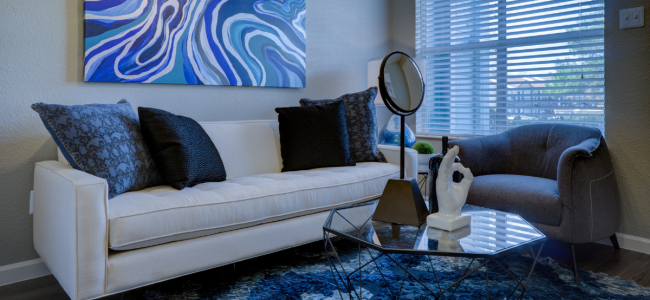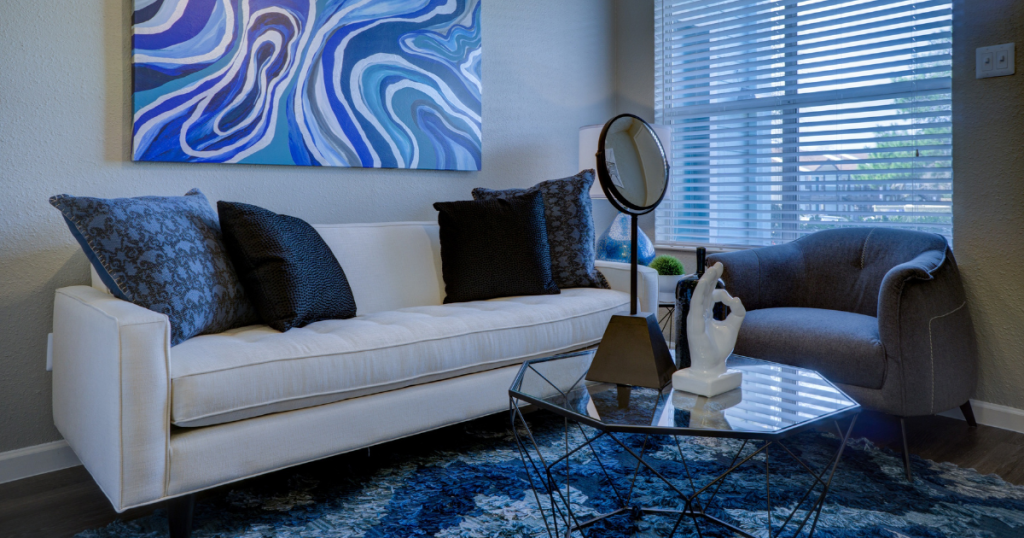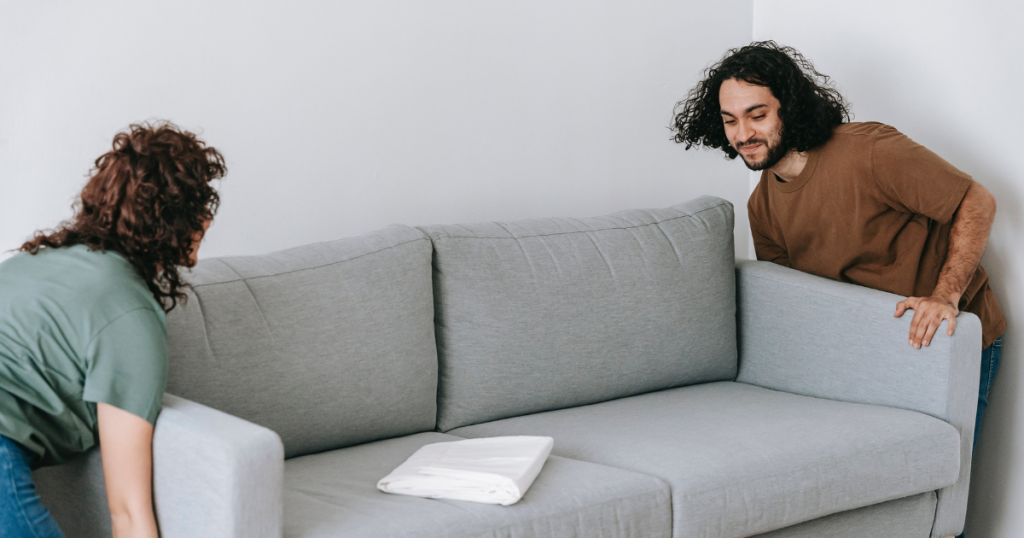

If you have a leather sofa at home, you know how it can elevate the look of your living space. Not only do they exude a sophisticated charm, but they are also long-lasting and cozy. However, if not given proper care, these sofas can lose their shine and become dirty, which can greatly reduce their aesthetic appeal. To keep your leather sofa looking brand new, we’ve put together 5 simple steps to clean and maintain it.
Prepare the Sofa for Cleaning
If you intend to clean your leather sofa, you must first properly prepare it. This will guarantee that the cleaning procedure proceeds smoothly and that you get the best results possible.
To begin, remove any loose dirt or debris that may be resting on the surface of the sofa. You may simply accomplish this by using a soft-bristled brush or a vacuum cleaner with a soft brush attachment. But, to avoid scratching the leather, be cautious when cleaning.
Following that, it is critical to inspect the sofa for any stains or patches. If you discover any flaws, use a leather cleaner created particularly for the type of leather your sofa is made of. To ensure that the cleaner does not damage the leather, always try it on a tiny, inconspicuous section of the couch before using it on a larger scale.
Next, make sure the space is well-ventilated and that you have all of the cleaning equipment you need. This will make cleaning simpler and more efficient. When you’ve completed these procedures, you’re ready to go on to the next stage of the cleaning process.
Identify the Type of Leather
Cleaning your leather sofa is a vital duty that must be done with care. Before you begin, you must first ascertain what sort of leather your sofa is constructed of. Each type of leather necessitates its own set of cleaning procedures and supplies, and using the wrong ones might cause harm to your couch.
Aniline, semi-aniline, and colored leather are the three most popular varieties of leather used in sofas. Because aniline leather is the most fragile and porous, it is prone to stains and fading. Semi-aniline leather has a protective layer that makes it more durable than aniline leather. The most durable sort of leather is pigmented leather, which contains a top layer that resists stains and fading.
To determine the type of leather on your couch, look for any information that came with it or go to the manufacturer’s website. You may also do a basic test by adding a drop of water to a concealed part of the leather. If the water absorbs, the leather is most likely aniline. It’s probably semi-aniline or colored leather if it beads up on the surface.
Apply a Leather Cleaner
Congratulations on your new leather sofa! Keeping it clean and looking like new is essential to ensure it lasts for years to come. To achieve this, you’ll need to identify the type of leather your sofa is made from and choose a suitable leather cleaner.
Leather cleaners are specifically designed to remove dirt, grime, and stains from leather surfaces without causing any damage. However, before you start cleaning your sofa, it’s important to read the instructions carefully and follow them closely.
Some leather cleaners require dilution with water, while others can be used directly on the surface of the leather. So make sure you understand the instructions before starting.
When you’re ready to clean, use a soft cloth or sponge and work in small sections, starting from the top of the sofa and working your way down. Apply the cleaner gently, using circular motions, and be careful not to oversaturate the leather with the cleaner.
Once you’ve cleaned the entire sofa, wipe it down with a clean, damp cloth to remove any residue. Then, leave the sofa to air dry completely before using it again.
Condition the Leather
Once you’ve cleaned your leather sofa, it’s important to give it some extra love by conditioning it. Conditioning your leather sofa helps to restore the natural oils that may have been lost during the cleaning process, and it also prevents the leather from cracking or drying out.
To condition your leather sofa, you’ll need to select a high-quality leather conditioner that’s specifically designed for your type of leather. Be sure to read the instructions carefully and follow them closely. Some conditioners may require the use of a cloth or sponge, while others may come in a handy spray bottle.
Start by applying the conditioner too small sections of the leather and massaging it in with a circular motion. It’s essential not to oversaturate the leather with conditioner, as this can cause damage over time. Once you’ve applied the conditioner, use a clean, dry cloth to wipe away any excess.
Give your sofa some time to air dry for a few hours before using it again. If your sofa gets a lot of use or exposure to sunlight, you may need to condition it more frequently to keep it in tip-top shape.
Protect the Leather
If you have a leather sofa, then protecting it is crucial to ensure its longevity and prevent damage from spills, stains, and other sources. Fortunately, one of the most effective ways to protect your leather sofa is by using a leather protector.
A leather protector is a specially formulated product designed to create a protective barrier on the surface of your sofa, repelling liquids and preventing stains from setting in. However, before applying any protector, ensure that your sofa is clean and dry.
To apply the protector, give the bottle a good shake and then spray a light, even coat over the surface of the leather. Using a soft cloth or sponge, gently work the protector into the leather, taking care not to oversaturate it.
After application, allow the protector to dry completely before using your sofa again. Depending on the type of protector you use, you may need to reapply it periodically to maintain its effectiveness.
Apart from using a leather protector, other preventative measures can help safeguard your sofa against damage. For example, avoid placing it in direct sunlight, as this can cause fading and cracking. You can also use coasters or protective mats to prevent spills and scratches.
FAQs
If you’re a proud owner of a leather sofa, you’ll want to ensure that it remains in excellent condition for as long as possible. To help you maintain your investment, we’ve compiled some answers to frequently asked questions about cleaning and conditioning your leather sofa.
Is it safe to clean my leather sofa at home?
Yes, it’s generally safe to clean your leather sofa at home as long as you follow the proper cleaning and conditioning techniques. However, if you have a particularly delicate or expensive leather sofa, you may want to consider hiring a professional cleaner.
Can I use regular soap or detergent to clean my leather sofa?
No, you should never use regular soap or detergent to clean your leather sofa, as it can damage the leather. Instead, use a leather cleaner that’s specifically designed for your type of leather. This ensures that the cleaner is gentle enough to avoid causing any harm to the leather while effectively cleaning it.
How frequently should I condition my leather couch?
It depends on the type of leather and how often the sofa is used. As a general rule, you should condition your leather sofa every 6–12 months. However, if your sofa gets a lot of use or is exposed to a lot of sunlight, you may need to condition it more frequently. Conditioning helps keep the leather moisturized, preventing it from drying out and cracking.
How do I remove stains from my leather sofa?
The best way to remove stains from your leather sofa is to address them immediately. Blot the stain with a clean, damp cloth, and then follow the cleaning and conditioning techniques outlined in this article. For particularly stubborn stains, you may want to consult a professional cleaner.
How can I prevent cracking on my leather sofa?
Regular conditioning is the best way to prevent your leather sofa from cracking. Additionally, you should avoid exposing it to direct sunlight, which can cause fading and dryness. Use a leather protector to help repel liquids and prevent stains from setting in. This will keep your leather sofa looking and feeling great for many years to come.



